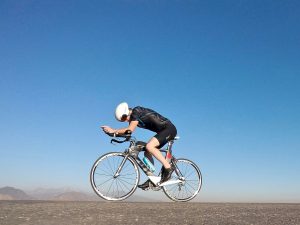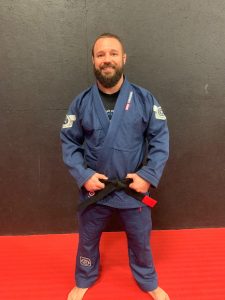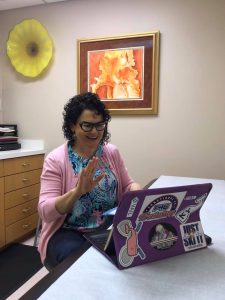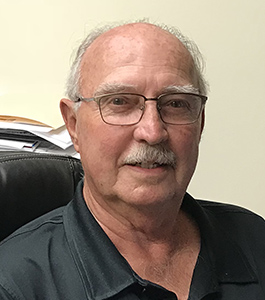Meet this month’s patient of the month Tina Johnson!

Tina was born in Indianapolis, Indiana, but raised in Milwaukee, Wisconsin where she attended the University of Wisconsin, Madison. “My mother is from Kentucky, so I came to Bowling Green every summer my whole life and always loved it. I decided to go to WKU for graduate school, and met my husband, Dee Johnson. We married and settled in Louisville, Kentucky and have two daughters, Ciarra, 32 and Kenya, 24.”
Tina is a member of a public service sorority, Delta Sigma Theta Sorority, Inc. She is currently the President of the Louisville Alumnae Chapter and is in her 2nd term. In 2018, Tina retired from being a School Social Worker for Jefferson County Public Schools after 30 years of service. During that time, she was recognized as School Social Worker of the Year and was also the President of the Kentucky Association for School Social Work and the President of the Midwest Council for School Social Work.
“I have been working part time for the University of Louisville, Kent School of Social Work, for 14 years now and love teaching others how to become great social workers. I have truly enjoyed my career of School Social Work!!”
Recently Tina experienced several life changing events, beginning with her testing positive for the coronavirus.
“I am not sure how I became infected with the virus, but the weekend before I got sick, I went to five different public places. It was a beautiful day that Saturday, so I ran a few errands. The city shut down that Monday, March 16th which is the very day I started feeling a bit sick. I felt very tired, I was running a low-grade fever and I just did not feel like myself. I took the test on Friday, March 20, 2020. The test took eight days to come back!! By the time it came back, I was in bed, very sick and I knew I had it before I got the results. My fever shot up to 101, I had the chills, I had a horrible cough, I had zero taste and smell, therefore no appetite, and just felt sicker than I have ever felt in my life. But the moment they called and told me I tested positive for the coronavirus, was still a horrible, shocking, scary feeling. I remember holding my breath, when I asked, so what does that mean!!?
Since I was able to breathe and would not need a ventilator, my husband and I decided I would stay at the house instead of going to the hospital.
The hospital did not feel safe as things seemed chaotic, plus my husband was not able to stay there with me. He was not going to drop me off and then leave and go back home! They told him to quarantine himself away from me at home, but he said no way, he was staying in the same room with me, so he could be there if I needed him. He said there was some nights, I was just moaning and groaning non-stop all night! He said he felt anguished because he was not sure how he could help me.
I kept losing weight because I was not eating at all. I said to my husband one night, “it is not the virus that is going to kill me, I will die of starvation and not having any nutrients in my body”. That really scared him, so he started bringing applesauce, crackers, mashed potatoes, Gatorade or whatever he could bring in the room to try to get me to eat and drink. When I finally was able to get some food down, I started throwing up violently every day and it was always so painful when that wave of nausea would come over my body. It made me dizzy and weak at the knees. I felt like crying, but never did. I was too sick to even cry. Everyday I would wake up hoping I would feel better, but it just did not happen, for at least three solid weeks!
My fever of 101 finally broke on Easter Sunday, April 12, 2020.
I thought that was symbolic that it was Easter, the Lord’s Day of Resurrection! I started to feel a little better and was able to eat a bit more. But then severe constipation set in once I started eating, to the point where I was bent over with pain. In between these episodes I was calling my doctor and she was prescribing meds for the nausea, the constipation, and the nagging dry cough. We just treated each ailment as it came up. Even after I started feeling better, I would still have this draining fatigue that would just hang on. I would get up, get dressed, eat a bit of dinner and before I knew it, I was putting on my pajamas again and going back to bed. I would look forward to laying back down every day.
So it is just something that takes a while to run its course and makes you feel like you could actually die! I kept thinking, I have not planned anything, I do not have my final wishes written down! It was very terrifying some nights. I do not know what I would have done without my husband of 37 years. I called him my Angel. He was truly there for me every minute. He finally took the test and he was negative even though he slept in the same bed with me every night. God kept him negative so he could take care of me! That is my philosophy anyway.”
Sadly, Tina’s 89 year old Mom was battling dementia during this time. She was quarantined to her room for so long at her facility, and did not understand what was going on.
“She is a very social person and she was not able to have any visitors. I normally saw her 3-4 times a week and we would have a good time. She was also very outgoing. She went into the hospital at the end of April because she stopped eating and drinking so her kidneys started to fail. I think she just got depressed from being quarantined so long and basically gave up. She did not know what happened to her family. She also could not have visitors in the hospital, but once they moved her to hospice, she could have one visitor. I was honest with them and told them I had dealt with the coronavirus, but my doctor said I had recovered. Because I did not have proof, they would not let me come to be with my mother.
I was so beyond devastated. I felt the coronavirus and quarantine had affected both of us. Luckily, my sister from Atlanta, drove up so she could be in the room with her and then did a Zoom connection to include my other sister in North Carolina and I in the room. Then I felt much better! Then I started to worry as I knew her time was near and I felt people would feel leery of me at the service. She passed away one day after Mother’s Day on May 11th. I went to Shawnee Park to take the Covid 19 test again and it came back one day before her service on May 15th. It was negative! I was grateful. Only ten of us could attend her service. That also made me sad.
I am different.
I have always been a positive, outgoing person, but I now feel even more empowered to live my best life! God spared me for a reason. There were people dying every day on the news from the coronavirus. But I continued to get better. As I age, I want to be more involved in my health options. I want to know what medications I am on and why. As a result of the virus, I ended up losing 40 lbs altogether and my goal is to maintain the weight loss and lose even morel I feel blessed every day that I am alive and I am still smiling! I have JOY within!
Dr Grossfield has been a positive light in my life.
I read her article when she was featured in the Women’s Magazine and it gave me a more personal side of who she is. She has brought all the latest medical information to me about my knees where we can avoid knee replacement altogether, which is a much healthier option for me. I am grateful for that. She is a great listener when you want to discuss your options and she makes you a part of the process and discussion. We decide together what we want to do to make things better for me. I just had knee surgery to get rid of inflammation and it took a year for my schedule to free up enough to wear a brace for four weeks. She did not pressure me. She let me decide when I was able to do the surgery and I appreciate that. I respect her knowledge and pleasant demeanor. I am looking forward to my bright future!”










Recent Comments